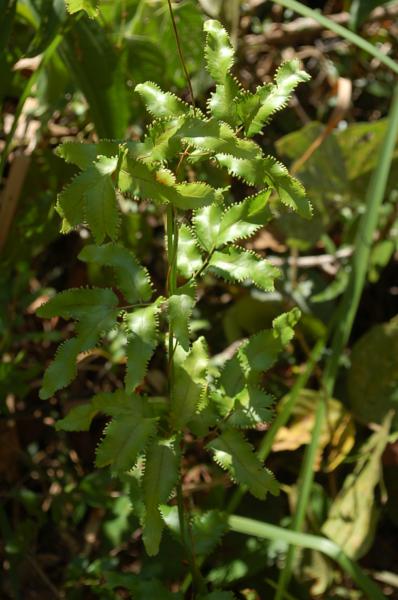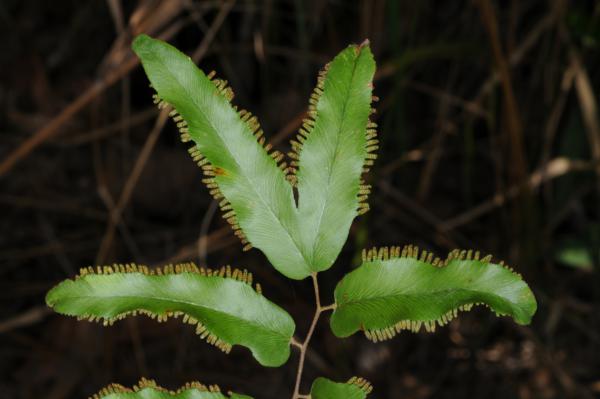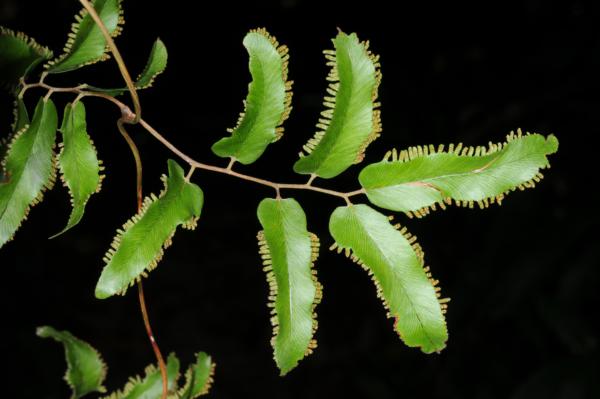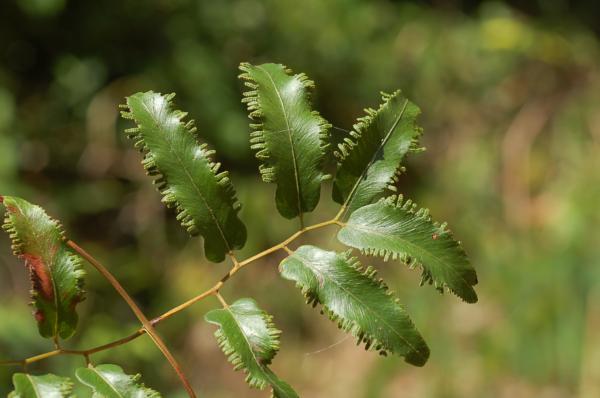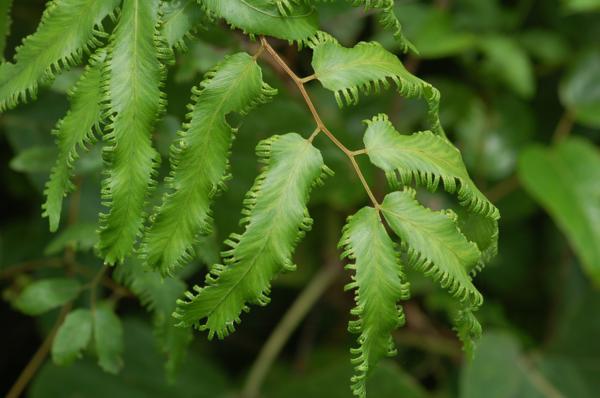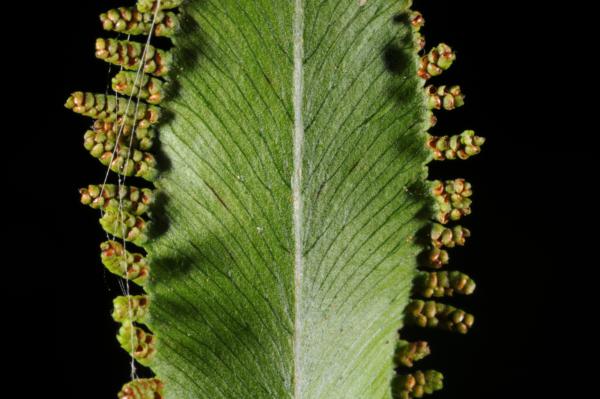
Lygodium salicifolium C.Presl
Family
Lygodiaceae
Nomenclature
Lygodium salicifolium C.Presl, Suppl. Tent. Pterid.: 102. 1845; C.Chr., Bot. Tidsskr. 32: 349. 1916; E.Smith, J. Siam Soc. Nat. Hist. Suppl. 8: 8. 1929; Tardieu & C.Chr., Fl. Indo-Chine 7(2): 41. 1939; Holttum, Fl. Males., Ser. II, Pterid. 1: 51, f. 6, 10 & 13a–b. 1959; Holttum, Dansk Bot. Ark. 20:16. 1961; Holttum, Dansk Bot. Ark. 23: 228. 165; Holttum, Rev. Fl. Malaya, ed. 2, 2: 630. 1968; Seidenf., Nat. Hist. Bull. Siam Soc. 19: 85. 1958; Ching, Fl. Reipubl. Popularis Sin. 2: 111, pl. 7, f. 7–9. 1959; Tagawa & K.Iwats., SouthE. Asian Stud. 3(3): 72. 1965; Tagawa & K.Iwats., SouthE. Asian Stud. 5: 34. 1967; Tagawa & K.Iwats., Acta Phytotax. Geobot. 23: 51. 1968; Tagawa & K.Iwats., Fl. Thailand 3: 64. 1979; Boonkerd & Pollawatn, Pterid. Thailand: 35, 83. 2000; Newman et al., Checkl. Vasc. Pl. Lao PDR: 28. 2007.
Lygodium flexuosum auct. non (L.) Sw.: Christ, Bot. Tidsskr. 24 112. 1901; Holttum, Rev. Fl. Malaya ed. 1, 2: 57. 1955 [‘1954’], p.p.
Lygodium circinnatum auct. non (Burm.f.) Sw.: Christ, Bot. Tidsskr. 24: 112. 1901; Hosseus, Beih. Bot. Centralbl. 28(2): 367. 1911; C.Chr., Bot. Tidsskr. 32: 349. 1916; Seidenf., Nat. Hist. Bull. Siam Soc. 19: 85. 1958.
Description
Rhizome shortly creeping, densely covered with blackish brown hairs. Fronds very large, climbing, to several. metres tall; stipes stramineous, minutely pubescent, very narrowly winged or with a distinct line at both sides; rachis like the upper part of stipes, 1.5–2.2 mm diam.; primary rachis-branches very short, up to 4 mm long, the apex dormant, covered with brown hairs; secondary rachis-branches pinnate (rarely basal branches slightly bipinnate with two small free lobes and one large terminal lobe), with about 4 pairs of leaflets and a terminal usually deeply lobed one; tertiary leaflets oblong-lanceolate, moderately acute at apex, cordate, subauricled, subhastate or in extreme form 5-lobed at base, minutely dentate at margin, typically 10 cm long but up to 17 cm, 2.5 cm broad; stalks of leaflets distinct but wanting in smaller leaflets, up to 1.2 cm long, with a distinct junction at base of laminae; lamina herbaceous to soft papyraceous, fresh green, almost glabrous on both surfaces except the hairy margin; every axis higher than the secondary rachis-branches with narrow but distinct wings, pubescent throughout, somewhat swollen at every junction. Sporangia-bearing lobes protruding at margin of tertiary leaflets, 2–5(–10) mm long, about 1.2 mm broad; indusia glabrous .
Distribution in Thailand
NORTHERN: Chiang Mai, Chiang Rai, Phayao, Lampang, Phrae, Sukhothai; NORTH-EASTERN: Loei; EASTERN: Nakhon Ratchasima; SOUTH-WESTERN: Kanchanaburi, Prachuap Khiri Khan; CENTRAL: Nakhon Nayok; SOUTH-EASTERN: Chon Buri, Chanthaburi, Trat; PENINSULAR: Surat Thani, Phangnga, Nakhon Si Thammarat, Phatthalung, Trang, Satun, Yala, Narathiwat.
Distribution in Laos
Khammouane, Luang Phrabang, Savannakhet, Vientiane.
Distribution in Cambodia
Kampot, Koh Kong, Kratie, Mondulkiri, Pursat, Siem Reap.
Wider Distribution
India (Assam) to Yunnan, Indochina, Hainan, Taiwan, throughout Malesia, southeast to New Guinea and Micronesia.
Ecology
On rather dry mountain slopes in tropical evergreen forest at low or medium altitudes.
Proposed IUCN Conservation Assessment
Least Concern (LC). This species is widespread and not under any known threat.
Notes
Uses. – Stems used in making handbags and hats.
Voucher specimens - Thailand
Phengkhlai 43, Phrae, Huay Ton Yang (P); Phengkhlai 619, Nakhon Ratchasima, Khao Yai (P); Middleton et al. 4602, Trat, Ko Chang, Near Thanmagon Waterfall (E).
Voucher specimens - Laos
Pedrono 79, Luang Phrabang (P); Poilane 12034, Savanakhet (P); Maxwell 99-172, Vientiane (CMU)
Voucher specimens - Cambodia
Geoffray 120, Kampot (P); Martin 1005, Koh Kong (P); Chevalier 31866, Kratie (P); Schnell 10292, Mondulkiri (P); Harmand 322, Pursat (P); Long et al. CL282, Siem Reap, Taprom Temple (P); Martin 1296, Siem Reap, Mt Kulen (P).
Habit
Apex of secondary rachis branch
Secondry rachis branch
Secondary rachis branch
Pinnules
Sori
Site hosted by the Royal Botanic Garden Edinburgh. Content managed by Stuart Lindsay, Gardens by the Bay, Singapore and David Middleton, Singapore Botanic Gardens. Last updated 24 January 2012
